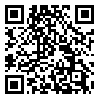Sun, Nov 24, 2024
[Archive]
Volume 13, Issue 4 (December 2017)
IJEEE 2017, 13(4): 310-317 |
Back to browse issues page
Download citation:
BibTeX | RIS | EndNote | Medlars | ProCite | Reference Manager | RefWorks
Send citation to:



BibTeX | RIS | EndNote | Medlars | ProCite | Reference Manager | RefWorks
Send citation to:
Okati N, Mosavi M R, Behroozi H. A Comparison between Different Meta-Heuristic Techniques in Power Allocation for Physical Layer Security. IJEEE 2017; 13 (4) :310-317
URL: http://ijeee.iust.ac.ir/article-1-981-en.html
URL: http://ijeee.iust.ac.ir/article-1-981-en.html
Abstract: (4903 Views)
Node cooperation can protect wireless networks from eavesdropping by using the physical characteristics of wireless channels rather than cryptographic methods. Allocating the proper amount of power to cooperative nodes is a challenging task. In this paper, we use three cooperative nodes, one as relay to increase throughput at the destination and two friendly jammers to degrade eavesdropper’s link. For this scenario, the secrecy rate function is a non-linear non-convex problem. So, in this case, exact optimization methods can only achieve suboptimal solution. In this paper, we applied different meta-heuristic optimization techniques, like Genetic Algorithm (GA), Partial Swarm Optimization (PSO), Bee Algorithm (BA), Tabu Search (TS), Simulated Annealing (SA) and Teaching-Learning-Based Optimization (TLBO). They are compared with each other to obtain solution for power allocation in a wiretap wireless network. Although all these techniques find suboptimal solutions, but they appear superlative to exact optimization methods. Finally, we define a Figure of Merit (FOM) as a rule of thumb to determine the best meta-heuristic algorithm. This FOM considers quality of solution, number of required iterations to converge, and CPU time.
Keywords: Physical Layer Security , Cooperation , Wireless Network , Power Allocation , Secrecy Rate , Meta-Heuristic
Type of Study: Research Paper |
Subject:
Mobile Communications
Received: 2016/08/11 | Revised: 2017/12/09 | Accepted: 2017/10/28
Received: 2016/08/11 | Revised: 2017/12/09 | Accepted: 2017/10/28
| Rights and permissions | |
 |
This work is licensed under a Creative Commons Attribution-NonCommercial 4.0 International License. |








